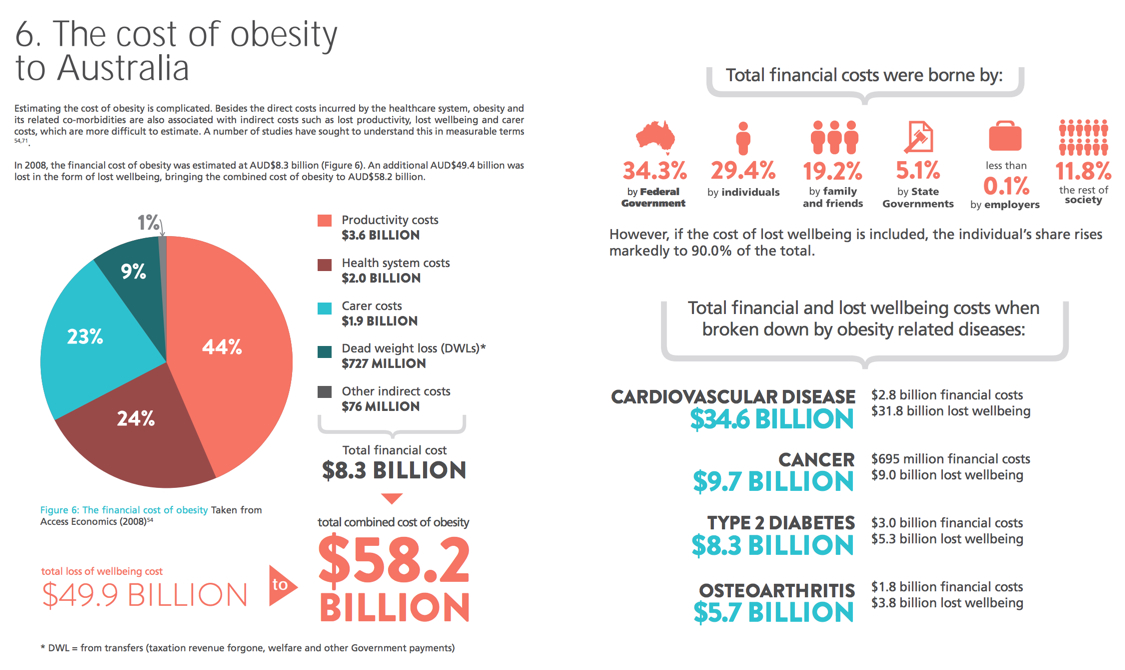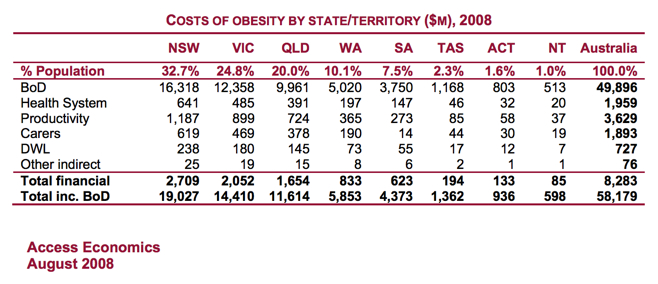|
![]()
| Financial cost of obesity – Australia Position1 #362029 The overall annual cost of obesity to Australian society and governments was estimated to be $58.2 billion in 2008 – which, when adjusted for relative population, suggests that the actual overall annual cost of obesity to the UK may closer to £100m per year. | 
- The total direct financial cost of obesity for the Australian community was estimated to be $8.3 billion in 2008. Of these costs, the Australian Government bears over one-third (34.3% or $2.8 billion per annum), and state governments 5.1%.
- This estimate includes productivity costs of $3.6 billion (44%), including short- and long-term employment impacts, as well as direct financial costs to the Australian health system of $2 billion (24%) and carer costs of $1.9 billion (23%).
- The net cost of lost wellbeing (the dollar value of the burden of disease, netting out financial costs borne by individuals) was valued at $49.9 billion.

|
+Citations (4) - CitationsAdd new citationList by: CiterankMapLink[1] The cost of overweight and obesity in Australia
Author: Stephen Colagiuri, Crystal M Y Lee, Ruth Colagiuri - Dianna Magliano, Jonathan E Shaw, Paul Z Zimmet, Ian D Caterson
Publication info: 2010, Medical Journal of Australia, 2010; 192 (5): 260-264.
Cited by: David Price 9:00 PM 27 October 2014 GMT
Citerank: (1) 400006Financial cost of obesity – AustraliaThe overall annual cost of obesity to Australian society and governments was estimated to be $58.2 billion in 2008 – which, when adjusted for relative population, suggests that the actual overall annual cost of obesity to the UK may closer to £100m per year.959C6EF
URL:
| | Excerpt / Summary Abstract
Objective: To assess and compare health care costs for normal-weight, overweight and obese Australians.
Design, setting and participants: Analysis of 5-year follow-up data from the Australian Diabetes, Obesity and Lifestyle study, collected in 2004–2005. Data were available for 6140 participants aged ≥ 25 years at baseline.
Main outcome measures: Direct health care cost, direct non-health care cost and government subsidies associated with overweight and obesity, defined by both body mass index (BMI) and waist circumference (WC).
Results: The annual total direct cost (health care and non-health care) per person increased from $1472 (95% CI, $1204–$1740) for those of normal weight to $2788 (95% CI, $2542–$3035) for the obese, however defined (by BMI, WC or both). In 2005, the total direct cost for Australians aged ≥ 30 years was $6.5 billion (95% CI, $5.8–$7.3 billion) for overweight and $14.5 billion (95% CI, $13.2–$15.7 billion) for obesity. The total excess annual direct cost due to overweight and obesity (above the cost for normal-weight individuals) was $10.7 billion. Overweight and obese individuals also received $35.6 billion (95% CI, $33.4–$38.0 billion) in government subsidies. Comparing costs by weight change since 1999–2000, those who remained obese in 2004–2005 had the highest annual total direct cost. Cost was lower in overweight or obese people who lost weight or reduced WC compared with those who progressed to becoming, or remained, obese.
Conclusion: The total annual direct cost of overweight and obesity in Australia in 2005 was $21 billion, substantially higher than previous estimates. There is financial incentive at both individual and societal levels for overweight and obese people to lose weight and/or reduce WC. |
|
|